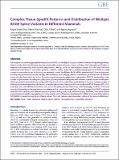Por favor, use este identificador para citar o enlazar a este item:
http://hdl.handle.net/10261/95707COMPARTIR / EXPORTAR:
 SHARE SHARE
 CORE
BASE CORE
BASE
|
|
| Visualizar otros formatos: MARC | Dublin Core | RDF | ORE | MODS | METS | DIDL | DATACITE | |

| Título: | Complex tissue-specific patterns and distribution of multiple RAGE splice variants in different mammals |
Autor: | López, Raquel CSIC; Rastrojo, Alberto CSIC ORCID CVN; Villate, Olazt; Aguado, Begoña CSIC ORCID | Palabras clave: | Alternative splicing Noncoding RNA Comparative genomics RAGE AGER mRNA isoforms |
Fecha de publicación: | 2013 | Editor: | Oxford University Press | Citación: | Genome Biology and Evolution 5: 2420- 2435 (2013) | Resumen: | The receptor for advanced glycosylation end products (RAGE) is a multiligand receptor involved in diverse cell signaling pathways. Previous studies show that this gene expresses several splice variants in human, mouse, and dog. Alternative splicing (AS) plays an important role in expanding transcriptomic and proteomic diversity, and it has been related to disease. AS is also one of the main evolutionary mechanisms in mammalian genomes. However, limited information is available regarding the AS of RAGE in a wide context of mammalian tissues. In this study, we examined in detail the different RAGE mRNAs generated by AS from six mammals, including two primates (human and monkey), two artiodactyla (cow and pig), and two rodentia (mouse and rat) in 6-18 different tissues including fetal, adult, and tumor. By nested reverse transcription-polymerase chain reaction (RT-PCR) we identified a high number of splice variants including noncoding transcripts and predicted coding ones with different potential protein modifications affecting mainly the trans membrane and ligand-binding domains that could influence their biological function. However, analysis of RNA-seq data enabled detecting only the most abundant splice variants.More than 80%of the detected RT-PCR variants (87 of 101 transcripts) are novel (different exon/intron structure to the previously described ones), and interestingly, 20-60% of the total transcripts (depending on the species) are noncoding ones that present tissue specificity. Our results suggest that RAGE undergoes extensive AS in mammals, with different expression patterns among adult, fetal, and tumor tissues. Moreover, most splice variants seemto be species specific, especially the noncoding variants, with only two(canonical human Tv1-RAGE, and humanN-truncated or Tv10-RAGE) conserved among the six different species. This could indicate a special evolution pattern of this gene at mRNA level. © The Author(s) 2013. | URI: | http://hdl.handle.net/10261/95707 | DOI: | 10.1093/gbe/evt188 | Identificadores: | doi: 10.1093/gbe/evt188 issn: 1759-6653 |
| Aparece en las colecciones: | (CBM) Artículos |
Ficheros en este ítem:
| Fichero | Descripción | Tamaño | Formato | |
|---|---|---|---|---|
| B_Aguado_Genome_Biol_Evol.pdf | 818,31 kB | Adobe PDF |  Visualizar/Abrir |
CORE Recommender
PubMed Central
Citations
21
checked on 16-abr-2024
SCOPUSTM
Citations
34
checked on 15-abr-2024
WEB OF SCIENCETM
Citations
31
checked on 26-feb-2024
Page view(s)
380
checked on 17-abr-2024
Download(s)
242
checked on 17-abr-2024

